| |||||||
| Search Forums |
| Advanced Search |
| Go to Page... |
 |
| Search this Thread |  389,291 views |
| | #1 |
| BHPian Join Date: Jan 2011 Location: Bangalore
Posts: 324
Thanked: 1,437 Times
| Boeing 777 - Pilot's Review The Boeing 777 is a long range, twin aisle, twin-engine jet manufactured by Boeing. Often referred to as the “Triple Seven”, it was the world’s first commercial aircraft entirely designed by computer. Its distinguishing features include enormous engines, a six-wheel landing gear and a circular fuselage cross section, along with a blade like tail cone. It was introduced in 1994, and has since been highly successful, bagging a total of 1590 orders. However, this will be replaced by the 777X by around 2019-2020, which will compete with the new Airbus A350-1000. This is a pilot's review of the Boeing 777, specifically the 777-300ER model. Note: The 777 is directly comparable only to the Airbus A330/A340. But it's extremely long range and high payload has allowed operators to replace the B747 and A380 routes with the B777, having multiple flights to a destination on the same day instead of one. Hence, you might find comparisons to the A380/B747 as well. What you'll like:
What you won't:
 Last edited by ampere : 13th May 2016 at 10:21. Reason: Fixed thumbnail to insert |
| |  (121)
Thanks (121)
Thanks
 |
| The following 121 BHPians Thank searchingheaven for this useful post: | .anshuman, 9thsphinx, aa_asif, Aditya, Akshay1234, akshay380, amitkb, aniket17, anilntny, Aragorn, ariesonu, ashpalio, AutoNoob, Avikbrio, Ayesha, bj96, bkishore_77, BlackPearl, blackwasp, BNM, bsdbsd, ChiragM, Contrapunto, Cyborg, Divya Sharan, djay434, dr. sen, Dr.AD, drdeepudev, dreamliner17, drive2eternity, gearedup, GeneralJazz, Grand Drive, GTO, gubbi555, harsh79, heavenlybull, hrk997, iamendangered, Jack Sparrow, jaspal singh, JayKis, JoseVijay, karan561, karuvally, Keeleri_Achu, khoj, KiloAlpha, krivbel, libranof1987, lloydofcochin, lovetorque, m.shekhar, mathuranuj, Meccanico, mikon, mooza, mpksuhas, Musa, myavu, n.devdath, nalinsaxena23, Nempuguru, niv26, noopster, phoenixash, prasadee, prashanthyr, quantobigboot, R2D2, Rajeevraj, raj_5004, rambo1o1, razor4077, RedDevil_KP, Rehaan, ritzy, roby.thomas, Roy.S, Rudra Sen, sagarpadaki, sandeepmdas, shipnil, ShortShifter, SILVERWOOD, Simhi, Sip, skchettry, SmartCat, somjith_nair, Speedshift, spookey, sriramr9, sri_tesla, Sting, subbaramu, sun_king, Sutripta, suyr, swiftnfurious, Tamarind, Tanveer_2558, The Brutailer, theexperthand, tifosikrishna, timuseravan, TOINGPOING, Turbanator, turbospooler, V.Narayan, Vasuki, Venkatesh.C, vinayrathore, virgopal, vishy76, VR/46_Chet, W.A.G.7, WAM-4, ysjoy, Zahoor23 |
| |
| | #2 |
| BHPian Join Date: Jan 2011 Location: Bangalore
Posts: 324
Thanked: 1,437 Times
| Re: Boeing 777 - Pilot's Review This review is going to consist of the following sections. Feel free to jump around as and when needed.
NOTE: Click any picture to open a larger higher-resolution version in a new window. Last edited by noopster : 16th May 2016 at 16:46. Reason: Added links :) |
| |  (44)
Thanks (44)
Thanks
 |
| The following 44 BHPians Thank searchingheaven for this useful post: | Aditya, ampere, aniket17, AppyS, Avikbrio, Ayesha, balenoed_, blackwasp, Divya Sharan, Dr.AD, dreamliner17, Fraz33r, GTO, Jack Sparrow, JoseVijay, krivbel, lloydofcochin, m.shekhar, mrvenka, Musa, Nempuguru, noopster, PapaBravo, PGA, phoenixash, R2D2, Rajeevraj, RedDevil_KP, Rehaan, roby.thomas, Rudra Sen, shetty_rohan, Speedshift, sriramr9, Sting, subbaramu, Tanveer_2558, theexperthand, timuseravan, Turbanator, Venkatesh.C, vinayrathore, Vishal.R, WAM-4 |
| | #3 |
| BHPian Join Date: Jan 2011 Location: Bangalore
Posts: 324
Thanked: 1,437 Times
| Re: Boeing 777 - Pilot's Review Design, development, production and entry into service The rivalry between Airbus and Boeing has been going on for many years now, and is seen by some as one of the most engaging and interesting duopolies out there in any industry. Back in the 1980’s, Airbus had weakened Boeing's share substantially. In response, Boeing tried developing a bigger & stretched version of the 767. But nobody was interested. Also troubling were the trade tensions between the United States and the European Union surrounding the subsidized entry of the A-300 in the early 1970s. The rivalry intensified considerably after Airbus introduced the narrow-body A320. By 1989, Boeing knew that a completely new aircraft was the only way out. And so the 777 was born. However, there was a problem. Boeing was running behind the competition. McDonnell-Douglas was already producing its MD-11 and Airbus was working on the A330/A340 family. The A330 had two engines, but the long-range A340 had four engines, which was the standard on transatlantic flights. Also important to note is the fact that the FAA had placed stringent restrictions on how far two engine aircrafts could fly from an airport where it could land if one engine failed. So it was very important for Boeing to ensure that the first 777 would have ETOPS certification to fly transatlantic as soon as it entered service. Four-engine aircrafts cost more to maintain than twin-jets, so that certification gave the 777 an edge over the comparably sized quad-jet A340 and the tri-jet MD-11. Design collaboration A big difference between B777 and other aircrafts produced before was that Boeing had called United and other operators to the drawing table, as well as people from Boeing's production teams. It was the first time that Boeing had involved the customers themselves in the design process. At the first group meeting in January 1990, a survey was distributed to the airlines, asking what each wanted in the design. Boeing and the airlines finally decided upon a basic design configuration: a cabin cross-section close to the 747's, capacity up to 325 passengers, flexible interiors, a glass cockpit, fly-by-wire controls, and 10 percent better seat-mile costs than the A330 and MD-11. The 777 was Boeing's first fly-by-wire airplane and used more composite material — about 12 percent of the plane — than any previous jetliner. The taste of success Even in the 90's, the 777 wasn't a very revolutionary airliner. Instead, it was the versatility and the reliability that took the 777 to where it is today. Also a very important factor that amplified the success of the 777 was the lack of direct competition. By 1995, McDonnell-Douglas' MD-11 had flopped. It hadn't lived up to what the company had promised to customers. Airbus stuck with its four-engine A340, but it was a losing battle. The program ended production in 2012. The company's smaller A330 has done well, booking almost as many orders as the 777. However, that plane is closer in size to Boeing's 767. Two 777 variants helped cement its lead in the twin-jet market. Boeing introduced the 777-200ER — or extended range — in 1997. That plane led the program in orders until it was superseded by the 777-300ER, which was first delivered in 2004. Last edited by searchingheaven : 13th May 2016 at 04:51. |
| |  (44)
Thanks (44)
Thanks
 |
| The following 44 BHPians Thank searchingheaven for this useful post: | Aditya, Akshay1234, Aragorn, ashpalio, audioholic, autospeaker, Ayesha, bkishore_77, Divya Sharan, Dr.AD, dreamliner17, Fraz33r, GTO, Jack Sparrow, jaspal singh, john doe, JoseVijay, libranof1987, lovetorque, m.shekhar, Musa, nalinsaxena23, Nempuguru, PapaBravo, pdma, phoenixash, R2D2, RedDevil_KP, Rehaan, roby.thomas, Rudra Sen, shetty_rohan, shipnil, Speedshift, sriramr9, Sting, swiftnfurious, theexperthand, timuseravan, Turbanator, turbospooler, Venkatesh.C, vinayrathore, Vishal.R |
| | #4 |
| BHPian Join Date: Jan 2011 Location: Bangalore
Posts: 324
Thanked: 1,437 Times
| Re: Boeing 777 - Pilot's Review Basic technical details -----------------------------------------------------------------------------------------------------------------------------------------------------------------------
----------------------------------------------------------------------------------------------------------------------------------------------------------------------- *Bleed Air : Bleed air produced by gas turbine engines is compressed air that is taken from the compressor stage of those engines, which is upstream of the fuel-burning sections. Last edited by searchingheaven : 13th May 2016 at 04:57. |
| |  (55)
Thanks (55)
Thanks
 |
| The following 55 BHPians Thank searchingheaven for this useful post: | Aditya, Akshay1234, ampere, Aragorn, ashpalio, autoskooll, Avikbrio, Ayesha, Baddychat, bkishore_77, blahman, bsdbsd, Contrapunto, Divya Sharan, dr. sen, Dr.AD, dreamliner17, GTO, jaspal singh, JoseVijay, kutts, Leoshashi, libranof1987, m.shekhar, Meer, Michael_Fanai, Musa, nalinsaxena23, Nempuguru, phoenixash, quantobigboot, R2D2, Rajeevraj, rambo1o1, RedDevil_KP, Rehaan, roby.thomas, rohitoasis, Rudra Sen, sagarpadaki, sdp1975, shipnil, silversteed, Speedshift, sridhar-v, sriramr9, Sting, swiftdiesel, swiftnfurious, TaurusAl, theexperthand, THE_DRIFTER, timuseravan, V.Narayan, Venkatesh.C |
| | #5 |
| BHPian Join Date: Jan 2011 Location: Bangalore
Posts: 324
Thanked: 1,437 Times
| Re: Boeing 777 - Pilot's Review Introduction to the cockpit and layout This is the cockpit of the Boeing 777. 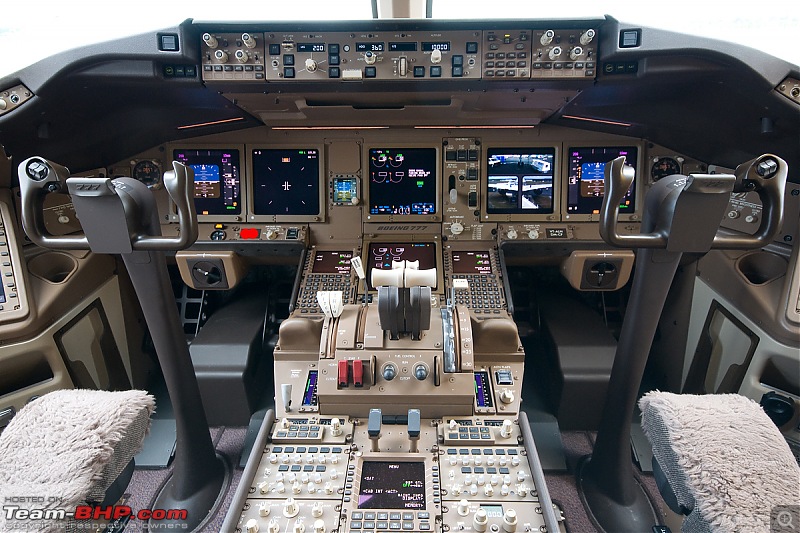 The layout of the cockpit is explained in the image below.  The two main displays in front of the pilot are the PFD (primary flight display; left) and ND (navigational display; right). The pilot and copilot each have a set, and there is a pair of shared DUs (display units) in the center (arranged top-and-bottom). The information shown on the PFD is explained in the picture below. 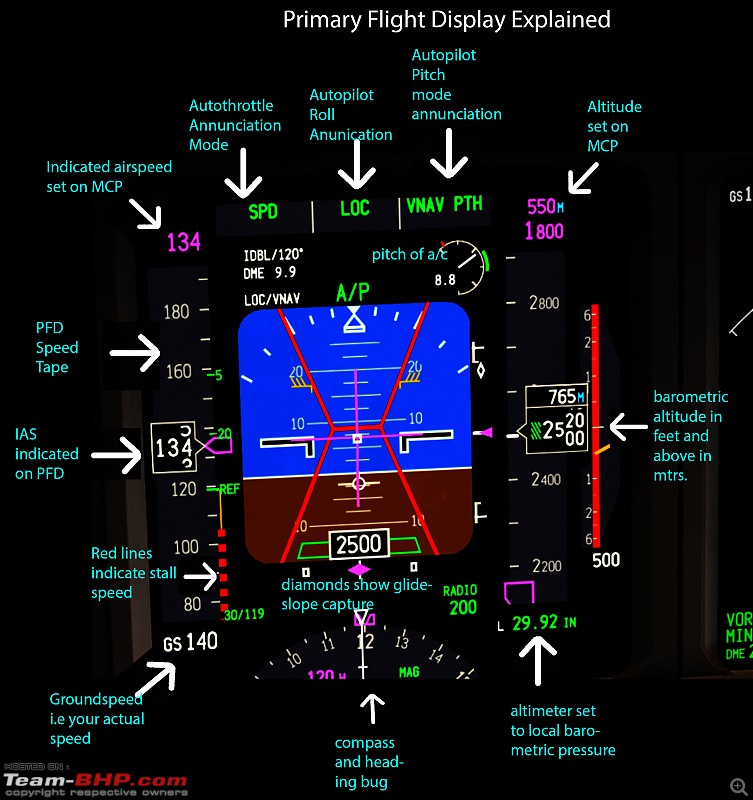 The Boeing 777 has a ground maneuvering camera system (GMCS). It provides pilots with real-time views of the landing gear, ground conditions and proximity to the pavement edge during taxi maneuvers using cameras mounted behind the nose gear and in both leading edges of the horizontal stabilizer. The images appear on a three-way, split screen, flight deck video display. 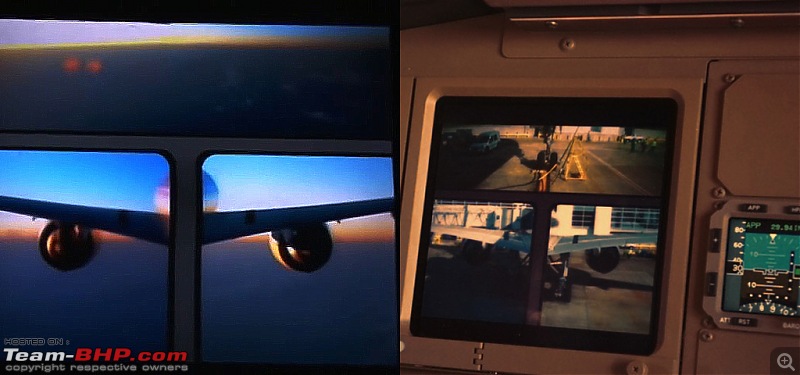  The MFD(Multifunction display) in the Boeing 777 allows us to request data using SATCOM. This data is directly displayed onto the MFD and can also be printed on paper using a small printer. 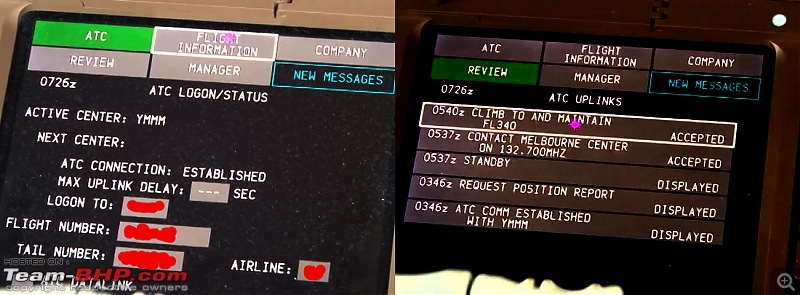 The other use of the MFD is for ECHKL i.e the electronic checklist. This is one thing that I really like on the 777. No more hassles of paper etc. Also, the software automatically checks off items which have been completed. For e.g if I have already pulled up the gear and then open the after takeoff checklist, the GEAR UP item will already be ticked. Here it is in action. Sorry for the really bad quality of pictures here. 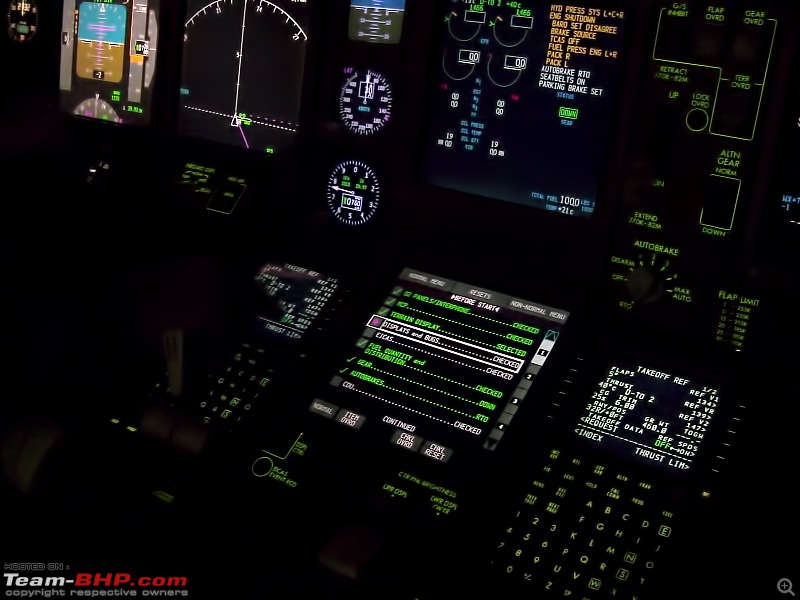 The 757 was infamous for having 31 dimmer switches to lower the lights in the cockpit. On the 777, everything is well thought out, including the single knob to reduce the cockpit lighting level. The MASTER BRIGHT switch also visible.  Shown here are the switches for the heater and display brightness adjustment.  Last edited by searchingheaven : 13th May 2016 at 06:05. |
| |  (57)
Thanks (57)
Thanks
 |
| The following 57 BHPians Thank searchingheaven for this useful post: | Aditya, Akshay1234, amitkb, ampere, aniket17, Aragorn, Arun.K, arvind71181, ashpalio, audioholic, autoskooll, Avikbrio, Ayesha, bkishore_77, bsdbsd, Contrapunto, Divya Sharan, Dr.AD, dreamliner17, ds.raikkonen, gearedup, GTO, heavenlybull, heavy_foot, HR 16, Jack Sparrow, JoseVijay, kutts, libranof1987, Lobogris, lovetorque, m.shekhar, Meccanico, mooza, Musa, Nempuguru, pdma, phoenixash, quickdraw, R2D2, rambo1o1, RedDevil_KP, Rehaan, roby.thomas, Rudra Sen, sagarpadaki, silversteed, SmartCat, Speedshift, sriramr9, Sting, swiftdiesel, swiftnfurious, theexperthand, timuseravan, Venkatesh.C, yash2424 |
| | #6 |
| BHPian Join Date: Jan 2011 Location: Bangalore
Posts: 324
Thanked: 1,437 Times
| Re: Boeing 777 - Pilot's Review The Autopilot/AFDS of the 777 is a delight to use and deserves an exclusive post. I will be going into the details here, so please feel free to ask questions. Autopilot Flight Director System The AFDS consists of three autopilot flight director computers (AFDCs) and the Mode control Panel. The MCP provides control of the autopilot, flight director, altitude alert, and autothrottle systems. The MCP is used to select and activate AFDS modes, and establish altitudes, speeds, and climb/descent profiles. The MCP looks like this.  Don't get confused by looking at it. Yes, there are a lot of buttons. But I will explain the function of each & every one below.
This is a photo of the FMC(Flight Management computer). This is the brain of the aircraft and tells the autopilot where to go, how to go, how fast to go, and what altitude to go at. When LNAV and VNAV are active, the FMC provides the data to the AFDS. Note that the MCP is the higher authority in case of a conflict. For eg. at DTY waypoint, the forecasted altitude is FL195. But let's say that ATC has cleared you only upto 15000 ft. So you will enter 15000 ft into the altitude window on the MCP. The 777 CAN NOT and WILL NOT cross 15000 ft(i.e the altitude dialled in the MCP). 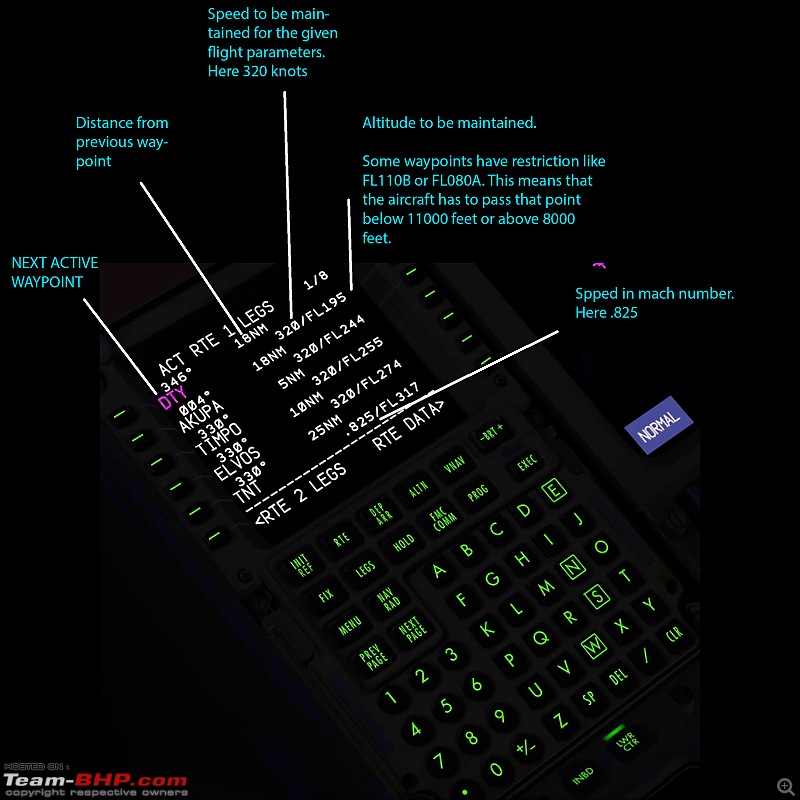 This is the EFIS(electronic flight instrument system) control panel. It is also visible at the extreme left of the MCP photo. In simple terms, the controls on this panel select display range and mode (for example, map or compass rose) and enter data (such as selected heading). It also has 2 additional knobs. The left one sets the minimums altitude(height) callout. This is the height at which the we must have adequate visual reference to the landing environment (i.e. approach or runway lighting) to decide whether to continue landing; or go around. The right one sets the barometric pressure for the baro altimeter. The buttons at the bottom are for displaying/hiding specific details for eg. Airports/Weather/Terrain/Stations/Position etc. 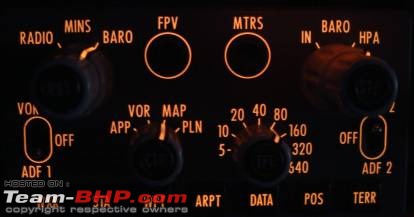 The Autopilot has to control three parameters to fly the plane. Its speed(throttle), its bank angle & its pitch. The roll(bank angle) is controlled by LNAV or HDG/TRK Hold/Select or LOC mode. The pitch is controlled using VNAV, FLCH, V/S, HOLD, or APP mode. The autothrottle modes can be any of the following • THR – The autothrottle applies thrust to maintain the vertical speed required by the pitch mode. • THR REF – Thrust is set to the selected thrust limit displayed on EICAS. • IDLE – Displayed while the autothrottle moves the thrust levers to idle; IDLE mode is followed by HOLD mode. • HOLD – The thrust lever autothrottle servos are inhibited. The pilot can set the thrust levers manually. • SPD – The autothrottle maintains the selected speed displayed on the PFD. Speed can be set by the MCP IAS/MACH selector or by the FMC, as shown on the FMC. The autothrottle will not exceed the operating speed limits or the thrust limits displayed on the EICAS. ---------------------------------------------------------------------------------------------------------------------------------------------------------------------------------------------------- Two important points: What does armed/active mean? When the mode is armed – it will activate automatically when certain conditions are met. Usually when the plane is in such position that the armed mode can take over. Armed mode is indicated by white text on primary flight display. Active mode is indicated by green text. This figure illustrates the difference between armed & active.  Difference between heading and Track Heading is where the nose of the aircraft points, while track is the ACTUAL path traveled over ground - just like a set of tracks I would leave behind in the snow or sand, relative to North. Last edited by searchingheaven : 12th May 2016 at 20:38. |
| |  (44)
Thanks (44)
Thanks
 |
| The following 44 BHPians Thank searchingheaven for this useful post: | Aditya, Akshay1234, ampere, Aragorn, ashpalio, autoskooll, Avikbrio, Ayesha, bj96, bsdbsd, Contrapunto, Divya Sharan, Dr.AD, dreamliner17, ganeshb, gearedup, GTO, hybridpetrol, john doe, JoseVijay, libranof1987, Lobogris, m.shekhar, mikon, Musa, Nempuguru, phoenixash, quantobigboot, rambo1o1, RedDevil_KP, Rehaan, ricky_speed, roby.thomas, Rudra Sen, sagarpadaki, SmartCat, SPIKE ARRESTOR, sriramr9, Sting, swiftdiesel, swiftnfurious, Tanveer_2558, theexperthand, Venkatesh.C |
| | #7 |
| BHPian Join Date: Jan 2011 Location: Bangalore
Posts: 324
Thanked: 1,437 Times
| Re: Boeing 777 - Pilot's Review Passenger's view of the 777 Now, I haven't travelled as a passenger in a 777 for an extended period of time. So I am not going to review this section personally. Keep in mind also that the experience, even on the same aircraft, can differ wildly by operator. The general seat configurations are 3-4-3 in the economy/coach class, 2-3-2 in business and 2-2 in first class. From a global perspective, the 10-abreast cabin in economy class does appear to be a growing trend, especially among European and Middle Eastern carriers. To my surprise, Qatar Airways has also started to introduce the 10-abreast cabin. The legroom varies from operator to operator, from airplane to airplane and even from seat to seat on the same airplane. They range from 31 to 34 inches in the coach or economy section. On American Airlines Boeing 777 planes crossing the Atlantic, most of the cabin seat have 34 inches of legroom but the seat in the middle cabin have only 33 inches. However, British Airways and Continental have a leg room of 31 inches. Delta, 31-33 inches and United Airlines with 31-32 inches. Safety Record & Incidents The 777 is one of the safest airplanes in the world. It has had a total of 5 hull loss crashes. And at least two of those three fatal crashes had nothing to do with the airplane itself.
Last edited by searchingheaven : 12th May 2016 at 20:04. |
| |  (45)
Thanks (45)
Thanks
 |
| The following 45 BHPians Thank searchingheaven for this useful post: | Aditya, ampere, anujmishra, Aragorn, arvind71181, audioholic, Avikbrio, Ayesha, bsdbsd, Contrapunto, Divya Sharan, Dr.AD, dreamliner17, GTO, heavenlybull, hybridpetrol, john doe, JoseVijay, libranof1987, m.shekhar, mikon, nalinsaxena23, Nempuguru, PapaBravo, pdma, phoenixash, quantobigboot, R2D2, rambo1o1, ramprakashr, RedDevil_KP, Rehaan, roby.thomas, Rudra Sen, sagarpadaki, shipnil, SmartCat, sriramr9, swiftdiesel, swiftnfurious, theexperthand, timuseravan, TOINGPOING, Turbanator, Venkatesh.C |
| | #8 |
| BHPian Join Date: Jan 2011 Location: Bangalore
Posts: 324
Thanked: 1,437 Times
| Re: Boeing 777 - Pilot's Review Comparison with other aircrafts & the future for Boeing 777 If the 777 story tells us anything, it's that the guy with the biggest twin jet wins. The 777's range, reliability and fuel efficiency have made it a popular choice for international routes. But the Boeing 777-300ER and 200LR are now 20 years old and will have to be replaced by the 777X by 2020. For now, the A350-1000 is head-to-head with the 777-300ER, as the following picture shows. [Last line is cost/seat/mile]. The problem however is that the A350-1000 will be delivered by 2020, by which time the 777X will be here. Then, the A350-1000 will compete with the 777X and will find it very difficult to hold its own. 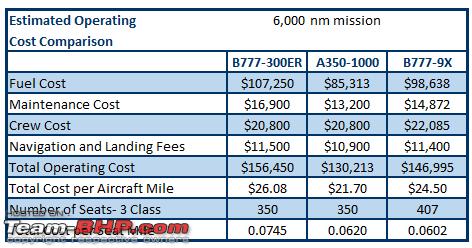 There is another problem as well. For the 777X, Boeing had to meet the specifications of the big gulf carriers. These carriers needed a plane with a big wing and very powerful engines in order to take off fully loaded during the summer. By adhering to these criteria, Boeing secured 235 orders for the 777X from these three carriers, mainly for the larger 777-9 variant. However, the 777X's big wing and powerful engines add weight, which hurts its fuel efficiency on shorter flights. Airbus has an edge with fuel efficiency since it is lighter, but it loses out in capacity to the 777-9X. If Airbus optimizes a stretched A350 for the European carriers, it will get the capacity but sacrifice the range. The problem is that most airlines want to simplify their fleets. The A350-8000(stretched version of A350-1000 having same capacity as the 777X). would be able to cover most long-haul airline routes, but most airlines do operate some flights beyond its likely range. If they need the 777-9's range for some routes, they might be willing to sacrifice some fuel efficiency rather than buying two planes in the same size segment. 777/A350 vs the double deckers If there is one thing that these twin jets have surely done, it's sounding the death knell of the quad-jets. The 747 was the queen of the skies for a very long time. As the world's first wide-body airliner, the Boeing 747 went on to change not only aviation but the entire tourism industry. But today, the industry has moved toward twin-engine planes such as the Boeing 777 and the Airbus A330. The 747 is essentially a dead man walking at this point. There comes a time when you have to decide between turning the page & closing the book. For the 747, if not for the A380, the time has probably come. Sad, though. It was the first aircraft that I really loved from the bottom my heart. The A380 has been a huge disappointment for Airbus so far. Like Boeing bet on the 747 in the 1970's, Airbus bet hugely on one aircraft, i.e the A380 - and lost. Sales, though initially strong, have slowed down in recent years. So far this year, Airbus has sold a grand total of zero A380s. And in spite of denials from the European manufacturer's top brass, speculation continues to mount about whether it can continue to produce this giant of the skies. The following table from Leeham Co., an aviation consultancy shows how the 7779X fares against the big birds. And no prizes for guessing who comes out smiling.  Last edited by searchingheaven : 13th May 2016 at 05:13. |
| |  (66)
Thanks (66)
Thanks
 |
| The following 66 BHPians Thank searchingheaven for this useful post: | --gKrish--, abhijitvp, Aditya, Akshay1234, amitkb, ampere, Aragorn, ashpalio, audioholic, autoskooll, Avikbrio, Ayesha, a_bharadwaj, Bhatt, bsdbsd, ChiragM, codelust, Contrapunto, Divya Sharan, Dr.AD, dreamliner17, ds.raikkonen, fash_1, Freewheelin_KD, GTO, heavenlybull, hybridpetrol, ike, jayakumarkp, JoseVijay, libranof1987, LordSharan, lovetorque, m.shekhar, mallumowgli, maverickrider00, mikon, mohammedismail, Nempuguru, pdma, phoenixash, quantobigboot, R2D2, Rajeevraj, Ravindra M, RedDevil_KP, Rehaan, roby.thomas, roy_libran, Rudra Sen, sbala, shipnil, SmartCat, Speedshift, Sting, swiftnfurious, Tanveer_2558, theexperthand, TheTeacher, THE_DRIFTER, turbospooler, V.Narayan, Venkatesh.C, vinayasurya, witwiky, Zinda |
| | #9 |
| BHPian Join Date: Jan 2011 Location: Bangalore
Posts: 324
Thanked: 1,437 Times
| Re: Boeing 777 - Pilot's Review DISCLAIMER: The information in this review is provided “AS IS” with no warranties, and confers no rights. While every caution has been taken to provide my readers with most accurate information and honest analysis, please use your discretion before taking any decisions based on the information in this review. This review does not represent the thoughts, intentions, plans or strategies of my employer. I do not own any stocks in any of the companies mentioned above and do not intend to influence your decisions. It is solely my opinion. Feel free to challenge me, disagree with me, or tell me I’m completely nuts. IMAGE SOURCES: Most of the images are my own. The rest of the shots(for eg. the introductory one) are taken from the Boeing company. Any other source than that is mentioned explicitly. Image have been edited wherever required to hide my operator name or the aircraft registration number. Last edited by searchingheaven : 12th May 2016 at 20:41. |
| |  (67)
Thanks (67)
Thanks
 |
| The following 67 BHPians Thank searchingheaven for this useful post: | --gKrish--, Aditya, amitkb, amitpunjani, amitwlele, Aragorn, arvind71181, audioholic, autospeaker, Avikbrio, Ayesha, a_bharadwaj, bharat4ever, blahman, bsdbsd, callvvijay, cbatrody, codelust, Contrapunto, Desmosedici, dileepcm, Divya Sharan, Dr.AD, E = mc˛, Fraz33r, Freewheelin_KD, GTO, ike, imkaushik, jayakumarkp, JoseVijay, lemedico, mallumowgli, mnvvishwa, mustang_shelby, nalinsaxena23, Nempuguru, PapaBravo, petrolhead_neel, Pferdestarke, quantobigboot, Rahul Bhalgat, Rajeevraj, Ravindra M, RedDevil_KP, Rehaan, roby.thomas, roy_libran, Rudra Sen, sagarpadaki, sdp1975, Shubhendra, SILVERWOOD, Skyline_GT, somjith_nair, Speedshift, sriramr9, Sting, swiftdiesel, swiftnfurious, Tanveer_2558, theexperthand, THE_DRIFTER, Venkatesh.C, vinit.merchant, wbd8779, Zinda |
| | #10 |
| Team-BHP Support  | Re: Boeing 777 - Pilot's Review Thread moved out from the Assembly Line! Rating review a full 5 stars  |
| |  (2)
Thanks (2)
Thanks
 |
| The following 2 BHPians Thank GTO for this useful post: | searchingheaven, THE_DRIFTER |
| | #11 |
| BHPian Join Date: Mar 2013 Location: Pune
Posts: 387
Thanked: 1,002 Times
| Re: Boeing 777 - Pilot's Review Thanks searchingheaven for the informative post. Also, more thanks for the format of the thread (separate posts for each section without overloading each section). To summarize, Boeing's acquisition cost is higher compared to Airbus but the running costs are much lower. The TCO approach means Boeing will win consistently. Surprised to see this as Indian aerospace has so many Airbus aircrafts. Maybe, in the single aisle segment, Airbus is more economical. Also, as India has an ecosystem of Airbus, the MRO network is more established leading to the preference to Airbus. |
| |  (1)
Thanks (1)
Thanks
 |
| The following BHPian Thanks turbospooler for this useful post: | GTO |
| |
| | #12 |
| BHPian Join Date: Dec 2015 Location: Bombay
Posts: 96
Thanked: 172 Times
| Re: Boeing 777 - Pilot's Review Have been an ardent fan of the 777-300ER ever since my first flight on one, aboard Singapore Airlines' flight to Singapore from Mumbai. This is the Rolls Royce (or Bentley if you prefer that) of airplanes, having killed the A340 family (which Airbus discontinued post the rise in oil prices in 2008/09) and also Boeing's own B747. While the A380 holds the distinction for the largest plane, the 777 has the most powerful engines ever built. I look forward to flights on the 777, and have actually booked tickets on airlines which fly this over the 747 / A330 given the superior comfort levels. Singapore Airlines has arguably the most comfortable configurations, with a 3-3-3 set-up in Economy for it's trans-Atlantic flights (to San Francisco) which leads to an extremely comfortable cabin with good legroom and seat width. Was also lucky enough to fly on SQ's business product from Singapore - San Francisco, with a 1-2-1 set-up. No other airline has such a spacious and lavish layout. My most recent flight was aboard Turkish Airlines brand new 777-300ER to Istanbul, which was also excellent. I'm not a fan of Emirates' cattle-class layout of 3-4-3 in economy which is pretty tight seating and constant elbow-clashing with your neighbour. Can't wait to see what Boeing does with the 777X! I also flew Air India's 787-900 a few months back, which is also an excellent product and due to the carbon fibre fuselage, the airline is able to maintain higher humidity levels in the cabin which leads to less exhaustion after a long flight. |
| |  (9)
Thanks (9)
Thanks
 |
| The following 9 BHPians Thank phoenixash for this useful post: | BashfulKlutz, bj96, Divya Sharan, GTO, lovetorque, searchingheaven, swiftdiesel, swiftnfurious, Venkatesh.C |
| | #13 |
| Senior - BHPian Join Date: May 2010 Location: TN-14
Posts: 1,095
Thanked: 1,691 Times
| Re: Boeing 777 - Pilot's Review Wow what a treasure trove of information!! Finished the thread completely. Great attention to detail sir. Finally I know (somewhat) what all those buttons do in the cockpit. |
| |  (1)
Thanks (1)
Thanks
 |
| The following BHPian Thanks arvind71181 for this useful post: | searchingheaven |
| | #14 | |
| BHPian Join Date: Dec 2015 Location: Bombay
Posts: 96
Thanked: 172 Times
| Re: Boeing 777 - Pilot's Review Quote:
In the Indian context, I believe Jet's fleet is majority 737s, which Indigo exclusively flies the A320. Air India is partial to the Airbus family as well. | |
| |  (6)
Thanks (6)
Thanks
 |
| The following 6 BHPians Thank phoenixash for this useful post: | Ayesha, GTO, libranof1987, mooza, R2D2, turbospooler |
| | #15 |
| BHPian Join Date: Apr 2008 Location: CBE-BLR-MAS
Posts: 431
Thanked: 686 Times
| Re: Boeing 777 - Pilot's Review I have done only one international travel and that had me travelling from BLR to LHR in a BA 747 and then from LHR to ATL in a BA777. While I loved the 747 (who wouldnt?) I was impressed by the 777 as a economy passenger. Starting with the 3-4-3 config vs the 3-3-3. And also the interiors were so much better, not just in age but in design. Later came back and read up all about the 777. That engine is just so impressive! Thank you for such an informative post!  |
| |  ()
Thanks ()
Thanks
 |
 |




 The part we all love to discuss.
The part we all love to discuss. 



